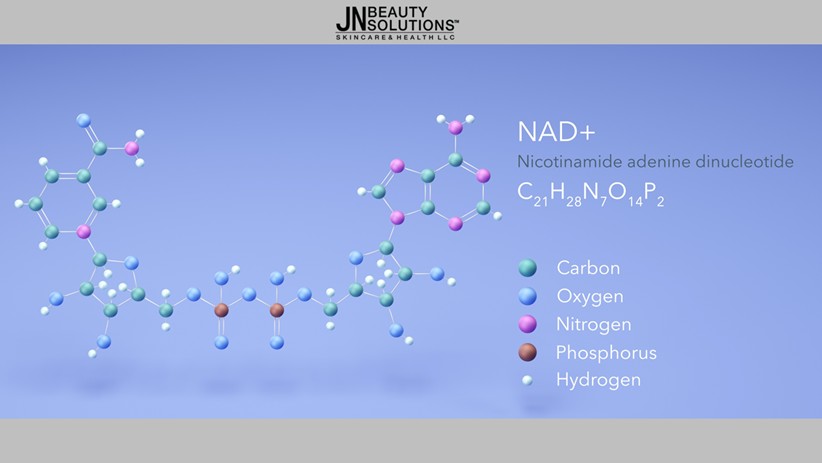OVERVIEW
NAD⁺ (Nicotinamide Adenine Dinucleotide) is a vital coenzyme found in every cell of the human body. It plays a central role in cellular energy metabolism, mitochondrial function, DNA repair, and regulation of gene expression. As an oxidized form of NAD, NAD⁺ functions as an electron carrier in redox reactions that are fundamental to energy production via oxidative phosphorylation and the Krebs cycle.
With aging and chronic disease, NAD⁺ levels decline significantly impacting cellular function, mitochondrial efficiency, and metabolic health. Restoring NAD⁺ has emerged as a promising therapeutic strategy in anti-aging medicine, neurodegeneration, metabolic syndrome, and chronic fatigue.

BIOLOGICAL FUNCTION AND MECHANISM OF ACTION
- NAD⁺ acts as a metabolic cofactor and signaling molecules in the following key processes:
- Energy Production (ATP Generation)
- NAD⁺ accepts electrons in glycolysis and the TCA cycle, converting to NADH
- NADH then donates electrons to the electron transport chain in mitochondria, producing ATP
- DNA Repair (PARP Activation)
- NAD⁺ is consumed by poly (ADP-ribose) polymerases (PARPs), which repair single-strand breaks in DNA
- Adequate NAD⁺ levels are critical to maintain genomic stability and prevent age-related mutagenesis
- Sirtuin Activation (Epigenetic Regulation)
- Sirtuins (SIRT1–SIRT7) are NAD⁺-dependent enzymes involved in gene expression, inflammation, circadian rhythm, and cellular stress response
- Enhanced NAD⁺ availability activates sirtuins and promotes mitochondrial biogenesis, autophagy, and longevity pathways
IMMUNOMETABOLISM & INFLAMMATION
- NAD⁺ modulates immune cell activity and influences cytokine expression
- Low NAD⁺ is associated with increased chronic inflammation and immune senescence
- NAD⁺ Decline and Health Implications
- NAD⁺ levels decline with aging, metabolic disease, stress, and toxin exposure. This decline contributes to:
- Mitochondrial dysfunction
- Cognitive decline and neurodegeneration
- Increased DNA damage and cancer risk
- Metabolic disorders, including insulin resistance and fatty liver
- Fatigue, poor recovery, and decreased resilience to stress
- Restoring NAD⁺ may help reverse or slow many age-associated pathologies and support optimal cellular health.
CLINICAL APPLICATIONS OF NAD⁺ THERAPY
Research and clinical use of NAD⁺ supplementation, especially via IV infusion, has expanded rapidly in recent years.
1. Neurodegeneration and Cognitive Health
NAD⁺ protects against oxidative stress and neuroinflammation
Preclinical models show benefits in Alzheimer’s, Parkinson’s, and stroke recovery
Supports synaptic plasticity, memory, and mental clarity
2. Metabolic Disorders
Improves insulin sensitivity, lipid metabolism, and mitochondrial function
May support management of type 2 diabetes, obesity, and NAFLD/NASH
3. Anti-Aging and Longevity
Enhances sirtuin activity, telomere maintenance, and autophagy
Shown to increase health span and delay age-related decline in animal models
Used in advanced wellness protocols for biological age reversal
4. Chronic Fatigue and Addiction Recovery
Boosts cellular ATP production in energy-deficient states
Commonly used to support detoxification, recovery from burnout, and substance withdrawal
NAD⁺ SUPPLEMENTATION AND DELIVERY METHODS
While oral precursors like NR (Nicotinamide Riboside) and NMN (Nicotinamide Mononucleotide) can raise NAD⁺ modestly, direct NAD⁺ IV therapy is considered the most effective route for rapid systemic replenishment.
- Intravenous NAD⁺: 250–1000 mg per session
Provides immediate bioavailability
Commonly used in anti-aging clinics, neurology, and integrative medicine - Oral NAD⁺ precursors: daily doses of 250–1000 mg
Variable absorption; slower onset
Sublingual and intranasal delivery are under investigation for brain-targeted therapy
SAFETY AND SIDE EFFECTS
NAD⁺ therapy is generally well-tolerated. However, rapid IV infusions may cause:
- Flushing, nausea, or chest tightness if administered too quickly
- Fatigue or mild headache during detox or mitochondrial upregulation
- Adverse effects are rare and typically dose-dependent. Slower infusion rates improve tolerability.
CONTRAINDICATIONS AND CAUTIONS
- Not recommended in individuals with active cancer, due to potential support of proliferative pathways
- Use caution in patients with uncontrolled cardiovascular disease or low blood pressure
- Should be administered by trained professionals in a clinical setting
CONCLUSION
NAD⁺ is a master regulator of energy metabolism, DNA repair, and cellular resilience. Declining NAD⁺ is a hallmark of aging and many chronic diseases. Replenishing NAD⁺ through IV infusion or oral precursors offers a promising strategy to restore metabolic balance, enhance mitochondrial function, and support long-term health.
As research progresses, NAD⁺ is becoming a cornerstone of precision longevity medicine, with wide-ranging applications in neurology, metabolism, and regenerative health.
For more product information, please contact
JN BEAUTY SOLUTIONS™

